Mad Men in Still Life
By Jason Haggstrom, July 23, 2010
Leading in to the Mad Men season four premier this Sunday, AMC has published a series of stunning portraits by photographer Frank Ockenfels 3. His images are dramatic works of art that capture, in the most iconic sense, some of the characters and themes from the show and its upcoming season.
 Eight of the show’s characters are featured in isolated portraits much like the character-based one-sheets we’ve seen for comic book films and other summer tentpoles. Typically, each character-based poster displays a distilled rendering of pure good, pure evil, or "sexy bitch" (a relatively modern archetype that is prevalent in many of today’s action films). But while Ockenfels’ Mad Men portraits utilize a similar approach to action film one-sheets, the character theming isn’t so one-dimensional. Instead, his portraits act as still life (the emphasis being on "life") where the fixed subjects are nearly as complex as their moving counterparts from the show. That these actors can convey such complexity in a single, still pose is a credit to the immense talent of the players, the photographer, and the quality of the series on the whole.
Eight of the show’s characters are featured in isolated portraits much like the character-based one-sheets we’ve seen for comic book films and other summer tentpoles. Typically, each character-based poster displays a distilled rendering of pure good, pure evil, or "sexy bitch" (a relatively modern archetype that is prevalent in many of today’s action films). But while Ockenfels’ Mad Men portraits utilize a similar approach to action film one-sheets, the character theming isn’t so one-dimensional. Instead, his portraits act as still life (the emphasis being on "life") where the fixed subjects are nearly as complex as their moving counterparts from the show. That these actors can convey such complexity in a single, still pose is a credit to the immense talent of the players, the photographer, and the quality of the series on the whole.
Of great interest to me is the portrait of Don Draper. When the show drew a parallel between the death of JFK and Betty’s discovery of Don’s secret origin, the dissolution of their marriage, and the sale of the firm, I wondered if it might signal the figurative death of the Don Draper persona. At the very least, Don’s status as a patriarchal superpower was diminished when he succumbed to both Betty and Peggy at the season’s end. In Ockenfels’ portrait, Don’s eyes betray him as a wounded man. His stance—head down and his face partially shielded by his hand— further accentuates his state of mind going into season four. Don has rarely appeared so weak.
 But if Don’s portrait aludes to the era’s movement away from über-masculinity and patriarchal sentiment, it is the portraits of Peggy and Pete that embody the other side of the equation: JFK’s New Frontier and their roles as leaders in it. Where Don’s portrait reveals the emotionally damaged face of Dick Whitman (which had always been hidden behind the façade of Don), Peggy and Pete stand with so much confidence, attitude, and swagger that they may as well be wearing capes. Peggy, in particular, stands strong, empowered, and confident in a pose that recalls Darwyn Cooke’s rendering of Wonder Woman in his own riff on the societal changes of the era aptly titled The New Frontier. It’s Pete and Peggy who’ve see the revolution coming and they have moved quickly to establish their roles in a swifly changing society.
But if Don’s portrait aludes to the era’s movement away from über-masculinity and patriarchal sentiment, it is the portraits of Peggy and Pete that embody the other side of the equation: JFK’s New Frontier and their roles as leaders in it. Where Don’s portrait reveals the emotionally damaged face of Dick Whitman (which had always been hidden behind the façade of Don), Peggy and Pete stand with so much confidence, attitude, and swagger that they may as well be wearing capes. Peggy, in particular, stands strong, empowered, and confident in a pose that recalls Darwyn Cooke’s rendering of Wonder Woman in his own riff on the societal changes of the era aptly titled The New Frontier. It’s Pete and Peggy who’ve see the revolution coming and they have moved quickly to establish their roles in a swifly changing society.

 Ockenfels also captures the key players in a group of still life scenes that portray each character’s power or lack of it. In one scene, Joan is placed in a literal spotlight where her physical and material opulence can be better grasped. Joan looks to the viewer, recognizing that her power as an attention-getting object extends beyond the world within the photograph. Peggy isn’t included in this display of sexual power, but the look on her face, and her interest in something outside of the frame, lets us in on her indifference to such a display. In another scene, Peggy is relegated to the background as Betty and Joan dominate the room with their striking beauty. That Peggy can occupy the space with these two women is a fantastic testament to her growth as a character. She may not be in their class, physically, but in this burgeoning era of feminism and sexual equality, Peggy is a powerhouse. Equally fascinating to their scenes together are the images of these characters in isolation, especially those of the three women.
Ockenfels also captures the key players in a group of still life scenes that portray each character’s power or lack of it. In one scene, Joan is placed in a literal spotlight where her physical and material opulence can be better grasped. Joan looks to the viewer, recognizing that her power as an attention-getting object extends beyond the world within the photograph. Peggy isn’t included in this display of sexual power, but the look on her face, and her interest in something outside of the frame, lets us in on her indifference to such a display. In another scene, Peggy is relegated to the background as Betty and Joan dominate the room with their striking beauty. That Peggy can occupy the space with these two women is a fantastic testament to her growth as a character. She may not be in their class, physically, but in this burgeoning era of feminism and sexual equality, Peggy is a powerhouse. Equally fascinating to their scenes together are the images of these characters in isolation, especially those of the three women.
Betty Draper, a woman whose identity was defined by her role as the wife of a powerful man, is reduced to near silhouette as she sits alone. The blonde of her hair, cream of her skin, and silken luxery of her dress blend together to illustrate Betty’s complete loss of power that comes with the loss of her marriage. She can apply the image of sexuality to her frame on command, but it’s only a façade to conceal what she lacks in actual identity.
The difference between Betty and Joan is that Joan doesn’t allow the men in her life to define her level of power (with one, brief exception). Joan’s power is all in the aesthetics, which she just happens to be in complete mastery of. Joan’s scene alone finds her re-applying perfection before returning to the room she so clearly owns.
Ockenfels’ shot of Peggy on the staircase is my favorite of the group. Unlike Joan and, to some degree, Betty, it’s not Peggy’s sexuality that gives her definition. Peggy is tough and self-assured and has no compunction with carving out her own space in the world, wherever she damn well pleases (here, she takes the stairs). It’s Peggy’s self-confidence that attracts the look from the man at the bottom of the image. But Peggy doesn’t need to be looked at to hold power; she needn’t return his look.
To see more photos from the gallery, go to amctv.com
![]()


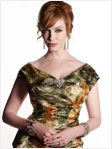



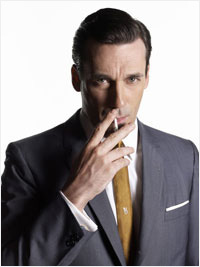

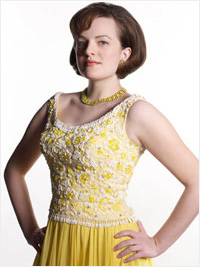
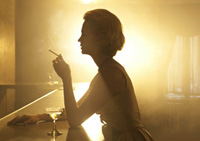
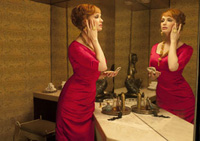

2 Comments
By Megan on July 24, 2010 at 9:21 AM
Glad you put into words what my subconscious mind must have been telling me when it said, “Wow! I really LIKE those photos!” While you captured much about the photos, I also have a few thoughts. I LOVE the photo of Peter “swimming” upstream of the other men. He’s certainly a rising tour de force and a leader, but he’s going to do it in a way that goes against the status quo and counter to what his contemporaries anticipate from the era. You can see that also in the full group shot at the end. He takes center stage, challenging Don’s placement there, yet is seated the lowest of anyone else in the group, noting his current power level. Don’s face in the Don/Joan/Peggy photo (where Peggy is looking off to the side) interestingly betrays his utter lack of power in a presence such as Joan’s (note the slack jaw and “off stage” face composure), most likely because he has never mastered his own false identity of power, as well as his outright curiousity admiration for how she sustains that power (note the curious and boldly staring eyes). Betty’s silhouette shot also reveals an interesting note in her character’s developing independence from men, as she is seated uncharacteristically alone and uncharacteristically in a bar, yet the shot of her in her “housewifely” flowered dress with the reflection of men’s trousers indicates her continued struggle with that side of her identity and her intrinsic preference to default to the scenario that includes a man taking charge. And finally, one can’t help but notice the not-so-subtle telephone placement in the Roger-in-the-shadowed-hallway shot, which leads me to believe that there will be a bit of telephone hanky-panky in this next season, to follow up on the several steamy, yet sincere phone calls he shared with Joan last season as well as his over-asserted insistence that he really is in love with Jane. You’re right — this cast and the photographer are geniuses!
By Jason Haggstrom on July 24, 2010 at 10:08 AM
Awesome insights! That photo of Pete “swimming upstream of the other men” as you say is certainly a favorite of mine as well (http://tinyurl.com/245axbz). Those who know the show can see that Pete’s not being squeezed, he’s separating himself from the pack.
Another favorite of mine that I left out of the post is the shot of Don sitting alone. There’s an anonymous woman’s body (no head, just a body) standing over his shoulder yet she’s not garnering his attention at all. Fantastic foreshadowing of Don’s state of mind going into season four. Has Don (or should I say Dick?) lost his abilities to take and control women?
Leave a Comment